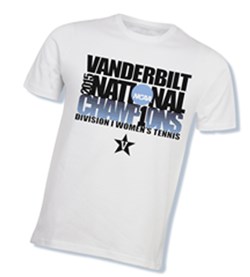VOL. 39 | NO. 29 | Friday, July 17, 2015
For VU’s Williams, it’s not all about game-day attendance
By Tom Wood

Williams
Vanderbilt, the smallest and only private school in the SEC, has always lagged the league in attendance.
The Commodores, even during the back-to-back 9-4 teams of 2012 (37,860) and ’13 (35,675), failed to fill the stadium (capacity (40,550).
And when the fortunes of the 2014 plummeted to 3-9 under first-year coach Derek Mason, home attendance dropped by an average of 1,347 to 34,258.
Those numbers are a concern, but not a worry to Vanderbilt athletics director David Williams.
He says on-campus attendance is still an issue and that the future of college athletics isn’t just about television and the revenue it generates.
“There’s two things we need to understand about attendance,” he says. “It’s not an unpredictable situation. I think the television balances it.
“When you start to put so many things on TV or any media, and the concept of how you can watch things, is so much different than they were yesterday. You had to predict (declining attendance) was a possible outcome.
“Obviously, if you look at the increase in revenue that we get from our membership in the SEC, a lot of that is from the broadcast dollar.
“So on one hand, the decline of attendance is sort of replaced by the increased revenue we get from selling that product to the media. Of course, what we’d like to do is have both.”
And having both is why Williams is vigilant about keeping Vandy fans coming to games.
“So then you refocus and say, ‘OK, what is it that we can offer on-site that you can’t get in your living room with your large-screen TV and two steps from your kitchen and one step from your bathroom?

The Barnes & Noble at Vanderbilt University bookstore offers shirts celebrating the school’s national champions.
“That’s how I look at it, and so what you have to do is go back to your demographics. Who are you trying to attract and what are the things that will make them want to come? What is it about coming to the game that you cannot get on TV?”
Good questions, but the answers aren’t easy.
Williams points to fan experience, citing the Commodore baseball team’s recent trip to the College World Series. The defending champions failed to repeat, losing to Virginia in the best-of-three finals.
Among the Vandy fans on hand was ex-Vandy pitcher David Price, now an All-Star with the Detroit Tigers.
“Yeah, you got to see David Price in that (TV) interview, but I got to talk to David Price one-on-one.
“Can everybody do that? No, but could you see the excitement of the game, the excitement of the fans? Could you feel ‘The Wave’ in the stadium? Could you see what happened as we left the stadium, the crowd that was around us? No, you couldn’t get that on TV. So that’s what we have to do.
“(Attendance) still matters for a number of reasons, but you’re right. Our biggest competitor is us.
“Our biggest advantage is we’ve got (the SEC) network. Our biggest competitor to putting butts in seats is our own network. We would like that money to be on top of (attendance-generated revenue), not as a replacement. That’s where the challenge is going to be.”
Six days after Tennessee held its Nike launch party, Vanderbilt quietly issued a seven-paragraph news release that it had extended its own apparel deal with Nike through 2023.
“Last year, we finally became a Nike school and we work with Nike to help us with the design. And that is something that really more and more is being marketed to the young people,” Williams says.
“(On-field) success always spikes merchandise sales, not only our baseball team but our women’s tennis team. People always tend to buy more things that identify with that team,” Williams adds.
“You see a spike in things that say Vanderbilt baseball or College World Series or women’s tennis national champs. So what spikes is just Vanderbilt itself.’’
The Commodores’ school colors are black and gold, which make for a nice mix. They also have some pretty cool athletics slogans, like “Anchor Down!” that catch fans’ attention.
“We have seen our sales numbers go up every year. Obviously for the teams that have success, but we’ve seen the overall numbers go up,” Williams says.
“Then the other part of it is where you basically position (sales). I’d go to far places, and they would have Ohio State stuff, Michigan stuff but no Vanderbilt stuff. So the other thing was how do we get our stuff to the places where people are buying them?
“That was one of our problems in the beginning; we just didn’t have stuff out. We were more in tune your need to come here, and at the time, the bookstore was in the middle of the campus.
“Now the bookstore is over here (off West End inside Barnes & Noble), we carry stuff on the road. At the College World Series, we had a part of the hotel lobby that was selling nothing but merchandise.”
Williams says sales typically spike just before the season starts and around the holidays, but the goal is to move merchandise all year round.
“You look around Christmas and people are, ‘I want to buy something,’ but you’re looking for consistency. People will spike up (sales) when you have success, but if you want increase over time, you’re really going to have to get what the young people wear.”
And a coach’s personality can also affect sales. Fans will buy team gear if they like the message the coach is selling. But that’s a dangerous road to go down these days, he cautions.
“Coaches can help in the sense that a coach has a relationship with the fan base. It’s going to help with attendance, it’s going to help with merchandise,” Williams adds.
“That’s a work in progress and you have to be careful, because we live in a high social media world, and you’re putting a coach in a situation where they have to be much more careful about what they say and who they say it to.”